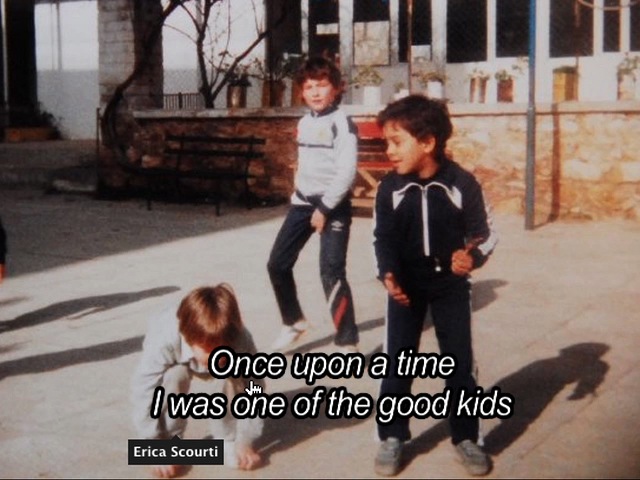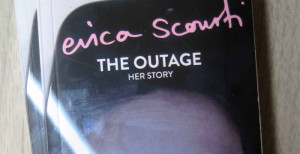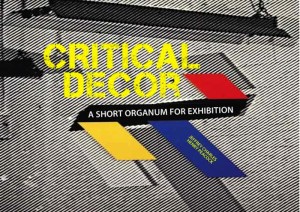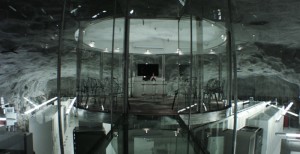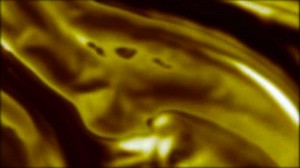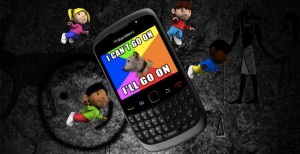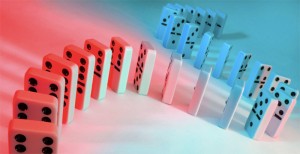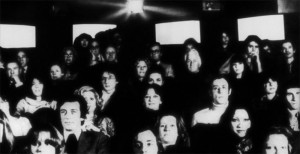With so many artists working with the web, the status of the object in art has become increasingly pertinent. To some, the very idea of a digital object is inconceivable, to others, an aspect of materiality implicit in the wider sustenance of a network counts. But for some, the idea of data that can be transformed from mp3s to wav files, and still take on a unique status as an item, is forming. Not only in terms of a commodity such as a track, image or video owned by Vevo, but an almost ‘immaterial material’ shared and customised by hundreds in a complex system of exchange between authors and contexts.
At Banner Repeater’s recent Appropriation Beyond the Object exhibition, there’s a screensaver built by artist Scott Mason that flashes bright-green text on a black background. At points phrases like “odds”, “leftwing” and “control the” are highlighted in red. In-between, there are stories about love, chewing gum and karaoke. Elsewhere “Valley” and “geeks” is crossed out. One constant, however, is a sense of unending flux. Every few seconds a different part of the image flickers, as a chunk of text is removed and replaced. No part stays settled and the narrative is almost impossible to follow, as parts re-appear from a never-ending story.
The Moment between Creativity and Commodification, is in fact Scott Mason, Harry Burke, Annie Davey, John Hill, Pedro Neves Marques, Sally O’Reilly and Frances Scott’s work, in what is essentially a collectively written piece that takes the form of a live media file displayed on a monitor in an exhibition space. To many, the answer to the question, “where is the object?” would be simple, i.e. “it’s the screen”. And let’s not be too conceptual here yet. They’re not at all wrong.
Even in post-internet art, a theory that argues we’ve gone beyond ‘cyberspace’ and ‘real space’ as opposites, into a place where both are one and the same, there’s an acceptance of physical screens as a pose to the content displayed on them. But what about the online object itself? Does it exist? And if so what can it tell us about not only physical objects but the fundamental ways in which something becomes more than a ghostly terabyte lost in the machine?
In the most radical hypothesis, every single electron that makes up the endless stream of data across the web forming into pixels of letters you read, are objects. As in a much-cited BBC News report, every time you enter a Google search, 0.2g of carbon dioxide is produced; a physical connection, as well as an environmental one that simply can’t be ignored. It’s a reality that brings the very reasons for digitally produced arts existence, as one of the cheapest materials available on the market, into question.
For now, however, let’s focus on a hypothetical cyberspace, in which objects are created through an interaction between user and software. Are mp3s, WMVs and Jpegs objects, and, if so, why? It seems obvious that a song, starting at 0:00 seconds and stopping at 3:35, is produced as one item that can be uploaded, downloaded and shared as a single, tangible entity. But it wasn’t always so. Tracks were found as part of other objects like CDs, cassettes and vinyl records; laser cut, written or pressed into what became an object. The Net then, has made it possible to atomise content into what can more tangibly be seen as singular objects. A digital video file, by this logic, is also one item in a folder to be uploaded or downloaded, even at the length of an entire Hollywood Blockbuster.
Video artist Erica Scourti’s work, in which audio is pressed onto visuals from spliced clips of found footage on YouTube, gives a better understanding of this type of object in art. Key words in her work are typed into search engines such as “woman” and “nature”, while yielding stock footage files that can be ripped and edited into new entities; further disseminating into others work. “In ‘Citizen Choice’ made earlier in 2010, I used stock video paired with audio taken from positive affirmation podcasts” Scourti explains, “this is a clearly appropriative work, directly ripping off the original images and audio files”.
Scourti sees video mpegs as a material to work with. They are an “existing language provided by the stock as the starting point for [my] re-performances”. These are ‘collaborations’ as such, engaging with existing clichés and representations of life – “especially women in nature”, she comments, “which are socially encoded and not purely my own”. Afterwards the works become freely available on YouTube, well-tagged and distributed, once again becoming stock, ready to be appropriated.
In contrast, however, ‘Women Nature Alone’ (2011) attempts to re-use the visual and textual language of stock footage. It shows the infrastructure, which allows it to be easily circulated, such as the banks of stock images stored at the The Getty, and the meta-data (titles, keywords and captions) which enable their movement. It’s a new way of working that reflects a new value for images based on velocity, swarm, circulation and wide distribution, rather than scarcity; a phenomenon, brought on by networked technology, raising questions about the value of artworks. “Is the most widely seen artwork the most valuable, and does this depend on its ability to be easily understood?” asks Scourti. “And what happens when artworks as images are circulated with no indication of their original context or meaning?”
It’s an acceptance of the immaterial nature of the web, a utopian free-for-all in many ways and one that writer Harry Burke, in the context of his contribution to Mason’s work ‘Creativity and Commodification’ describes as “liberating… in the sense of sending a short bit of text off and then seeing what different forms and directions it got morphed into”. But Burke disagrees that he had no control: “injecting 300 words into it seems like quite an insertion of narrative or more like memory or desire perhaps”.
Others however, in a system of exchange, relinquish all authorship, and allow for metadata only as a trail with which to track back, if that. Wikipedia, a hypertext document that relays a user from one source to another, in a web of data with no foreseeable end, acts as an open source site that can at any time be extended, copied or edited by thousands of users. It’s use of CreativeCommons media and voluntary staff gives it a free-form structure with a vast array of information and little sense of ownership.
When it comes to raw text, this system of exchange within Wikipedia is utopian. Based on an alternative economy, in which the only monetary costs are technical and administrative, the sentences are nothing more than data produced collaboratively. An authorless material to be worked with refined and improved, as with Scourti’s stock footage. Both only become objects when boundaries are placed. It could direct commoditisation, such as the case when publisher Zendot proposed to print hundreds of Wikipedia articles into volumes. It could be a simple claim to authorship, as is the case with Scourti and Burke’s work. The technical architecture that hosts data, or frames of reference around data, give others a sense of ownership over a meme they might not have even created.

It’s at the point when someone makes a claim to a digital service or piece of data, it seems, that it becomes a digital object, in much the same way that offline, no one would argue that a collage was a form of theft unless someone had ownership over the manipulated imagery. The moment, then, that someone claims data is their intellectual property, placing boundaries around that data, is when a text, image, video or CAD file becomes an object.
No longer will they be found on open source sites such as Wikipedia, unless they are provided at the discretion of an individual. Artist-led DIS Magazine also has its own stock library of images, meant to disturb the stereotypes found in mainstream sites, such as Getty Images, but you have to pay to use or modify the content. It is subject to availability. Furthermore, to be archived or displayed, the owned data is reliant on physicality, be it the materials that run the power, or the objects on which they are displayed.
At first, this might seem inconsequential but you only have to consider the worthlessness of physical currency in post-war hyperinflation, stacked in wheelbarrows and nothing more than a piece of paper embossed with logos and illustrations, to consider how easily an object can simply become a fuel, ready to be chucked into the fire. Bitcoins are the new currency, and their worth as objects is similarly reliant on a collective consciousness that deems them to be of worth. Text, like an artwork, can mean absolutely nothing if it does not resonate with an audience. If no one makes a claim to it or places value in it, it may as well not exist at all. **
share news item
